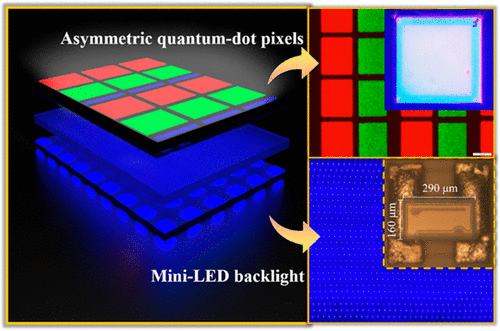当前位置:
X-MOL 学术
›
ACS Photonics
›
论文详情
Our official English website, www.x-mol.net, welcomes your
feedback! (Note: you will need to create a separate account there.)
Asymmetric Quantum-Dot Pixelation for Color-Converted White Balance
ACS Photonics ( IF 6.5 ) Pub Date : 2021-06-10 , DOI: 10.1021/acsphotonics.1c00596 Enguo Chen 1 , Jianyao Lin 1 , Tao Yang 1 , Yu Chen 1 , Xiang Zhang 1 , Yun Ye 1 , Jie Sun 1 , Qun Yan 1 , Tailiang Guo 1
ACS Photonics ( IF 6.5 ) Pub Date : 2021-06-10 , DOI: 10.1021/acsphotonics.1c00596 Enguo Chen 1 , Jianyao Lin 1 , Tao Yang 1 , Yu Chen 1 , Xiang Zhang 1 , Yun Ye 1 , Jie Sun 1 , Qun Yan 1 , Tailiang Guo 1
Affiliation

|
Pixelated quantum-dot color conversion film (QDCCF) is attractive for next-generation, high-pixel-density, full-color displays. However, how to achieve white balance of these QD converted displays puts forward a new challenge, because the final light-emitting area is redefined by the apertures of the QD formed subpixels. Based on this, this paper presents an effective white-balance realization approach by precisely defining an asymmetric aperture ratio among three primary-color subpixels of the QDCCF. Based on the measured photoluminescence characteristic of quantum-dot photoresist (QDPR), the theoretical aperture ratio can be derived by the spectral radiation energy and external quantum efficiency (EQE) of QDCCFs for the target D65 white-balance state. A bilayered device architecture, combining a blue mini-LED backlight and a pixelated QDCCF, was simulated and experimentally assembled to verify the theoretical design. The simulated chromatic coordinates obtained from the QDCCF precisely agree with the target white-balance point. Experimental patterning and pixelation of the designed QDCCF were achieved by a precise photolithography process. Measured results show that a white-light output was achieved with the chromatic coordinates of (0.2822, 0.2951) and the color gamut of 115.09% NTSC (National Television System Committee) standard. The deviation of the experimental chromatic coordinates is within ±0.05 to the D65 standard light source. The proposed white-balance realization approach featured by the aperture adjustable subpixels of a chromatic QDCCF may open up a new route for color reproduction in emerging display technologies.
中文翻译:

用于颜色转换白平衡的非对称量子点像素化
像素化量子点颜色转换膜 (QDCCF) 对下一代高像素密度全彩显示器具有吸引力。然而,如何实现这些QD转换显示器的白平衡提出了新的挑战,因为最终的发光区域是由QD形成的子像素的孔径重新定义的。基于此,本文提出了一种有效的白平衡实现方法,通过精确定义 QDCCF 的三基色子像素之间的非对称孔径比。基于测量的量子点光刻胶(QDPR)的光致发光特性,可以通过QDCCFs的光谱辐射能量和外量子效率(EQE)推导出目标D65白平衡态的理论孔径比。双层设备架构,结合蓝色迷你 LED 背光和像素化 QDCCF,被模拟和实验组装以验证理论设计。从 QDCCF 获得的模拟色度坐标与目标白平衡点精确一致。设计的 QDCCF 的实验图案化和像素化是通过精确的光刻工艺实现的。实测结果表明,在色度坐标为(0.2822、0.2951)、色域为115.09% NTSC(国家电视系统委员会)标准下实现了白光输出。实验色坐标与D65标准光源的偏差在±0.05以内。提出的以彩色 QDCCF 的孔径可调子像素为特征的白平衡实现方法可能为新兴显示技术中的色彩再现开辟一条新途径。
更新日期:2021-07-21
中文翻译:

用于颜色转换白平衡的非对称量子点像素化
像素化量子点颜色转换膜 (QDCCF) 对下一代高像素密度全彩显示器具有吸引力。然而,如何实现这些QD转换显示器的白平衡提出了新的挑战,因为最终的发光区域是由QD形成的子像素的孔径重新定义的。基于此,本文提出了一种有效的白平衡实现方法,通过精确定义 QDCCF 的三基色子像素之间的非对称孔径比。基于测量的量子点光刻胶(QDPR)的光致发光特性,可以通过QDCCFs的光谱辐射能量和外量子效率(EQE)推导出目标D65白平衡态的理论孔径比。双层设备架构,结合蓝色迷你 LED 背光和像素化 QDCCF,被模拟和实验组装以验证理论设计。从 QDCCF 获得的模拟色度坐标与目标白平衡点精确一致。设计的 QDCCF 的实验图案化和像素化是通过精确的光刻工艺实现的。实测结果表明,在色度坐标为(0.2822、0.2951)、色域为115.09% NTSC(国家电视系统委员会)标准下实现了白光输出。实验色坐标与D65标准光源的偏差在±0.05以内。提出的以彩色 QDCCF 的孔径可调子像素为特征的白平衡实现方法可能为新兴显示技术中的色彩再现开辟一条新途径。











































 京公网安备 11010802027423号
京公网安备 11010802027423号